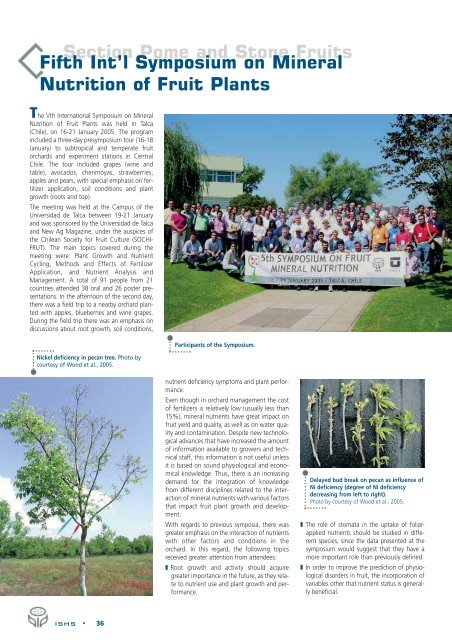Chronica - Acta Horticulturae
Chronica - Acta Horticulturae
Chronica - Acta Horticulturae
Create successful ePaper yourself
Turn your PDF publications into a flip-book with our unique Google optimized e-Paper software.
Section Pome and Stone Fruits<br />
Fifth Int’l Symposium on Mineral<br />
Nutrition of Fruit Plants<br />
The Vth International Symposium on Mineral<br />
Nutrition of Fruit Plants was held in Talca<br />
(Chile), on 16-21 January 2005. The program<br />
included a three-day presymposium tour (16-18<br />
January) to subtropical and temperate fruit<br />
orchards and experiment stations in Central<br />
Chile. The tour included grapes (wine and<br />
table), avocados, cherimoyas, strawberries,<br />
apples and pears, with special emphasis on fertilizer<br />
application, soil conditions and plant<br />
growth (roots and top).<br />
The meeting was held at the Campus of the<br />
Universidad de Talca between 19-21 January<br />
and was sponsored by the Universidad de Talca<br />
and New Ag Magazine, under the auspices of<br />
the Chilean Society for Fruit Culture (SOCHI-<br />
FRUT). The main topics covered during the<br />
meeting were: Plant Growth and Nutrient<br />
Cycling, Methods and Effects of Fertilizer<br />
Application, and Nutrient Analysis and<br />
Management. A total of 91 people from 21<br />
countries attended 38 oral and 26 poster presentations.<br />
In the afternoon of the second day,<br />
there was a field trip to a nearby orchard planted<br />
with apples, blueberries and wine grapes.<br />
During the field trip there was an emphasis on<br />
discussions about root growth, soil conditions,<br />
Nickel deficiency in pecan tree. Photo by<br />
courtesy of Wood et al., 2005.<br />
Participants of the Symposium.<br />
nutrient deficiency symptoms and plant performance.<br />
Even though in orchard management the cost<br />
of fertilizers is relatively low (usually less than<br />
15%), mineral nutrients have great impact on<br />
fruit yield and quality, as well as on water quality<br />
and contamination. Despite new technological<br />
advances that have increased the amount<br />
of information available to growers and technical<br />
staff, this information is not useful unless<br />
it is based on sound physiological and economical<br />
knowledge. Thus, there is an increasing<br />
demand for the integration of knowledge<br />
from different disciplines related to the interaction<br />
of mineral nutrients with various factors<br />
that impact fruit plant growth and development.<br />
With regards to previous symposia, there was<br />
greater emphasis on the interaction of nutrients<br />
with other factors and conditions in the<br />
orchard. In this regard, the following topics<br />
received greater attention from attendees:<br />
❚ Root growth and activity should acquire<br />
greater importance in the future, as they relate<br />
to nutrient use and plant growth and performance.<br />
Delayed bud break on pecan as influence of<br />
Ni deficiency (degree of Ni deficiency<br />
decreasing from left to right).<br />
Photo by courtesy of Wood et al., 2005.<br />
❚ The role of stomata in the uptake of foliarapplied<br />
nutrients should be studied in different<br />
species, since the data presented at the<br />
symposium would suggest that they have a<br />
more important role than previously defined.<br />
❚ In order to improve the prediction of physiological<br />
disorders in fruit, the incorporation of<br />
variables other that nutrient status is generally<br />
beneficial.<br />
ISHS • 36

















